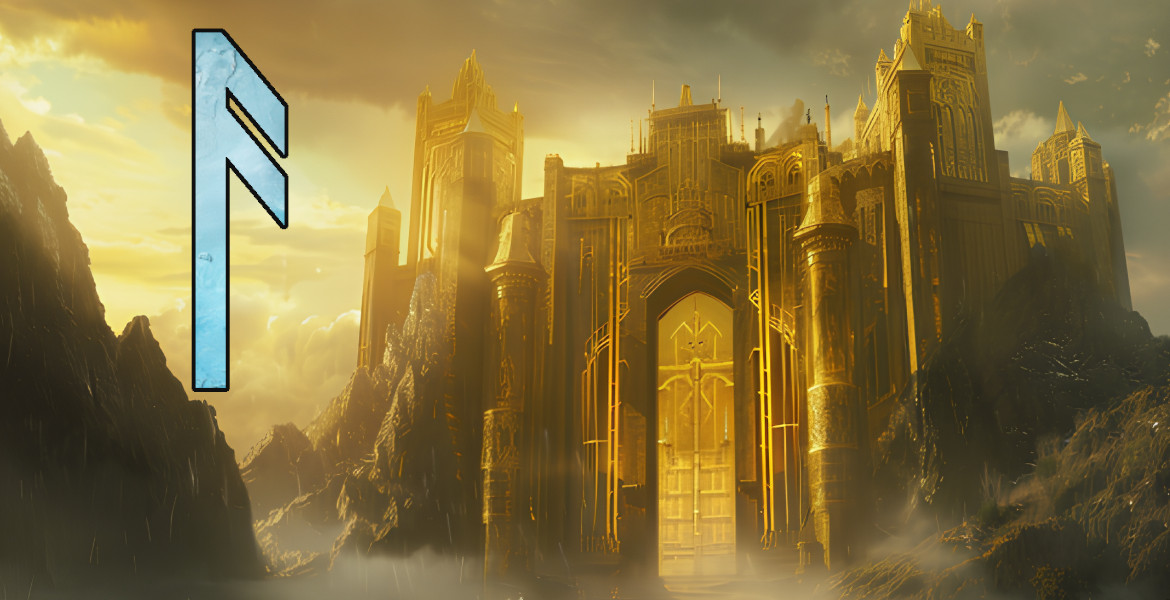ᚨ – Ansuz is the conventional name given to the a-rune, the fourth rune of the Elder Futhark, ᚨ, with the IPA sound value of
[ɑ̃], [o(ː)]. The rune means “god” and is the rune of the Æsir, the singular of which is áss.
Ansuz represents the divine voice and order, the animating life force and the essence of knowledge.
This article is part of our exclusive series on the origins and secrets of the Nordic runes in the Elder Futhark and the merits of the intriguing Uthark theory proposed by the Swedish philologist Sigurd Agrell, professor at Lund University, Sweden.
The Uthark is a secret cipher, based on positioning the Fehu rune at the end of the rune row, like an ace in a deck of cards, revealing esoteric philosophy reaching deep into the heart of Norse culture and religious beliefs.
In the Uthark, Ansuz is the third rune. In the context of Norse mythology, this is just as natural as the rune of origin, Uruz, being the first rune and the rune of the thurses and chaos, Thurisaz, being the second rune of the Uthark. Let’s take a closer look into why.
Meaning and interpretation
Ansuz is the synthesis of the first two Uthark runes, the rune that shapes the cosmic order from the primeval origins of existence (Uruz) and the chaotic influence of extreme polarities (Thurisaz).
Three is also the natural number of the divine, as is the case in many traditions, including the Norse mythology. The Norse gods themselves also appear in triads, such as Odin and his brothers Vile and Ve and, more famously, with his ravens Hugin (“thought”) and Munin (“memory”). The divine triad appears in the Valknut, the famous Norse symbol of completion, associated with Odin in particular as well as the nine worlds of existence.


Symbolism and magical use
Ansuz symbolizes the wisdom of the gods, that men may receive through inspiration, clairvoyance or magical visions. It also represents communication, both through the spoken and written word. Logically and magically, the Ansuz rune is therefore considered to promote connection with the divine, foster creative genius, clarity of thought and to enhance communication.
Many Ansuz runes appears on the Lindholm amulet from around year 500, found in Skåne, Sweden, in 1840. Like the Björketorp stone, the Kylver stone and the spell from the Icelandic book of black arts, the rune inscription on the Lindholm amulet is undoubtedly a magical formula – that reads:
ᚨᚨᚨᚨᚨᚨᚨᚨ ᛉ ᛉ ᛉ ᚾᚾᚾᚾ ᛒᛗᚢ ᛏᛏᛏ ᚨᛚᚢ
The fourth N-rune (ᚾ) has been interpreted by some as a question mark, but after examining it in a laboratory at Lund University, Sigurd Agrell believes it is a fourth N-rune.

Based on the Uthark, a clear gematria, with the familiar numbers 24 and 13 appears again, along with the number 9 which is almost interchangeable with 3 – as in the Valknut.
Like the spell in the book of black arts, there are 8 Ansuz runes in succession, giving the number 24 (8 times rune number 3). The three Tiwaz runes (see the poem in this article) correspondingly give the numerical value 48 – thus 24 times 2.
“ALU” also recurs, which through a divine triad of runes gives the number 24.
It is also interesting to note that between the 4 N-runes and the three Tiwaz-runes is written ᛒᛗᚢ – BMU, the runes for Woman, Man and Creation. These three runes add up to the sum of 37, which happens to be the sum of the recurring magical numbers 24 and 13.
Finally the sum of the whole rune row is 216, which is 24 times 9.
ᚨᚨᚨᚨᚨᚨᚨᚨ – AAAAAAAA
3*8=24
ᛏᛏᛏ – TTT
3*16=48/2=24
ᚨᛚᚢ – ALU
3+20+1=24
ᛒᛗᚢ – BMU
Woman, Man, Creation
17+19+1=37 (24+13)
Divination
When placed correctly in a rune reading, Ansuz can indicate the presence of an older mentor or other benevolent guide in one’s life, someone who will give good advice. It encourages one to listen closely and be receptive to the lessons life is offering.
The basics of rune divination
According to Norse belief, the runes represent aspects of the web of destiny, called the web of Urd (Wyrd). This web is intimately connected to time and the three Norns; Urd, Verdandi and Skuld. The Norns are weaving the threads of the web and represent what was, what is and what is to come.
The Roman historian Tacitus, among others, noted that rune divination was a widespread practice among the Norse. One of the most basic forms of such divination is to pray and draw three runes on twigs or cards which will signify the three Norns. By reading the web of Urd one may understand the present of Verdandi as well as the past, and also lift the veil of Skuld and see what lies hidden in the future.
It is also believed to be a sign that the questioner may develop his or her communication – or has an innate talent for it.
However, if the rune appears upside down, there is a danger of poor communication. Misguided advice, lies, and intrigue may be in store.
It is believed that Ansuz will appear more frequently if the reader is an intelligent and honest seeker, or works in roles such as a writer or educator.
Discover the following rune Raidho – the rune of Thor
The Nordic Times

















